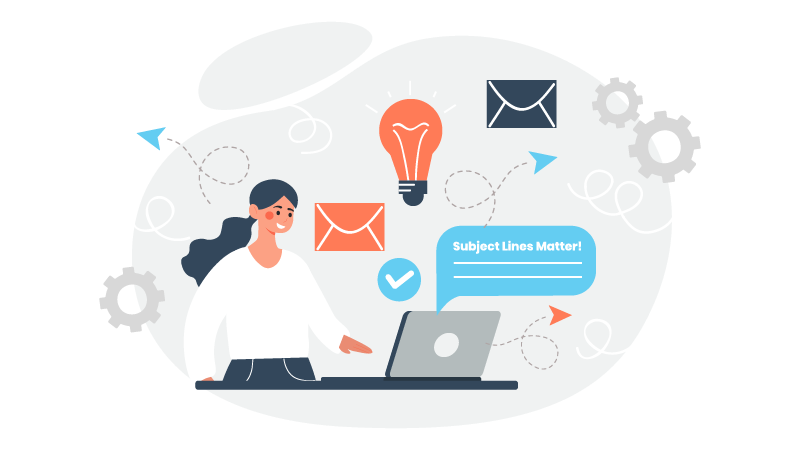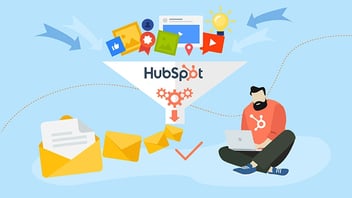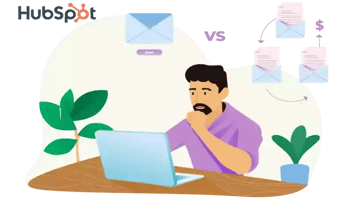电子邮件问题--我该如何改进?
在当今快节奏的数字环境中,电子邮件营销仍然是企业吸引受众并与其建立联系的基石。但它并非总是一帆风顺--一些挑战可能会阻碍您的电子邮件营销取得成功。
从电子邮件送达问题到打开率和列表增长,我们将深入探讨可行的策略,以加强您的电子邮件营销活动。
1.电子邮件的可送达性
电子邮件可送达性是任何成功电子邮件营销活动的基础。它是确保您的电子邮件到达目标收件人收件箱,而不是丢失在数字深渊中的做法。糟糕的电子邮件送达能力可能会成为营销活动的无声杀手,导致低打开率和高退订率。下面介绍如何改善这一问题:
监控电子邮件的可送达性
-
定期检查发件人信誉: 您的发件人信誉是决定您的电子邮件是进入收件箱还是垃圾邮件文件夹的关键。使用 Sender Score 或 Postmaster 等工具对其进行密切监控。通过发送相关、有价值的内容并避免垃圾邮件的做法来保持良好的声誉。
-
使用 DMARC、SPF 和 DKIM 认证:使用这些电子邮件验证协议来证明电子邮件的合法性。它们不仅有助于防止网络钓鱼,还能提高发件人声誉。这是与互联网服务提供商(ISP)建立信任的一个步骤。
降低退信率
-
保持电子邮件列表的清洁和更新:定期清理电子邮件列表,删除无效和过时的地址。高跳出率会对发件人声誉造成负面影响。使用列表验证服务确保数据的准确性。
-
实施双重选择进入流程:鼓励订阅者在注册后确认其电子邮件地址。这样既能确认他们的兴趣,又能减少列表中出现虚假或输入错误地址的几率。
避免垃圾邮件文件夹
-
编写吸引人的主题行和电子邮件内容:垃圾邮件过滤器会分析主题行和内容,以确定电子邮件的命运。避免使用过多的大写字母、感叹号或通常与垃圾邮件相关的触发词。取而代之的是,专注于创建能引起受众共鸣的有吸引力的相关内容。
-
针对移动设备进行优化,避免触发垃圾邮件: 许多人通过移动设备阅读电子邮件。确保您的电子邮件具有响应性,并能在不同尺寸的屏幕上良好显示。破损的布局或无法阅读的文本会触发垃圾邮件过滤器。在不同设备上测试您的电子邮件,确保它们在任何地方都显示良好。
如果电子邮件不适合移动设备,80%的用户可能会删除它。
通过注意这些电子邮件送达的最佳实践,您将增加电子邮件送达收件人收件箱的机会,并为您的品牌树立一个更值得信赖、更有声誉的形象。
2.打开率
打开率是电子邮件营销中的一个重要指标,因为它反映了您的主题行和电子邮件内容对受众的吸引力。较高的打开率意味着有更多订阅者对您的内容感兴趣。以下是一些提高打开率的策略:
撰写引人注目的主题行
-
对不同的主题行策略进行 A/B 测试: 尝试不同的主题行风格,如好奇心驱动型、利益聚焦型或紧迫感诱导型。A/B 测试有助于确定什么最能引起受众的共鸣。根据行之有效的方法不断完善主题行。
-
尽可能个性化主题行:包含收件人的姓名或提及他们过去与您品牌的互动,可以营造出一种个性化的感觉,从而提高电子邮件被打开的可能性。个性化就是要让订阅者感觉自己是有价值的个体,而不仅仅是另一个电子邮件地址。
66%的消费者取消订阅电子邮件是因为内容与他们无关。
细分电子邮件列表
-
为不同的受众群体量身定制内容: 并非所有订阅者都一样,他们的兴趣和需求也各不相同。根据人口统计、购买历史或参与程度来细分您的电子邮件列表。向每个细分用户群发送相关内容,如向忠实客户发送特别促销活动,向新用户发送信息丰富的内容。
-
分析参与数据以获得洞察力:密切关注受众群体如何回应您的电子邮件。关注他们参与最多的内容类型以及他们最活跃的时间。利用这些数据创建有针对性且及时的电子邮件营销活动。
请记住,打开率并不仅仅是让您的邮件被看到,而是要给受众留下良好的第一印象,并为进一步的互动奠定基础。引人入胜的主题行和个性化的内容有助于建立订阅者的期待和信任,使他们更愿意打开您的电子邮件并探索您的内容。
3.点击率
点击率(CTR)是电子邮件营销中的一个关键指标,因为它衡量了您的电子邮件如何有效地促使订阅者采取预期行动,如点击链接、访问您的网站或进行购买。点击率越高,说明您的内容和号召性行动越有吸引力。以下是提高点击率的方法:
设计响应式电子邮件模板
-
确保采用移动友好型设计:随着越来越多的用户使用移动设备查看电子邮件,设计响应式电子邮件模板至关重要。如果您的电子邮件在智能手机或平板电脑上显示效果不佳,您就有可能失去一大部分受众。
-
使用清晰醒目的 CTA 按钮:让收件人轻松了解点击位置。使用设计精良、吸引眼球的 "行动号召"(CTA)按钮,使其在电子邮件的其他部分中脱颖而出。只包含一个主要的 CTA,以避免混淆。
提供有价值的内容
-
解决客户问题或满足他们的需求: 您的电子邮件内容应针对订阅者的痛点和兴趣点。提供解决方案、分享有价值的见解或提供独家优惠,与他们的愿望产生共鸣。
-
使用有说服力的文案和视觉效果: 撰写令人信服的文案,鼓励用户采取行动。使用有说服力的语言和具有视觉吸引力的图片来支持您的信息。精心设计的电子邮件能够传达您希望受众点击的链接价值,从而提高点击率。
此外,还可考虑实施以下策略:
-
细分:针对不同的受众群体定制电子邮件内容。为不同群体创建独特的信息,确保内容和 CTA 与他们的兴趣或需求相关。
-
个性化:利用订阅者数据个性化电子邮件。根据收件人以前与您品牌的互动情况,称呼他们的姓名并向他们推荐产品或服务。
-
A/B 测试:试验不同的元素,如 CTA 按钮的颜色、文字或位置。A/B 测试可帮助您确定哪些变体表现更好,使您能够根据数据做出改进。
-
行为触发器:实施自动化,根据用户行为发送电子邮件--例如,根据过去的购买行为触发与放弃购物车或产品推荐相关的电子邮件。
通过专注于响应式设计、创建有价值的内容以及利用这些额外的策略,您可以提高点击率,鼓励订阅者采取所需的行动并进一步与您的品牌互动。
4.退订率
虽然建立电子邮件列表、提高打开率和点击率至关重要,但密切关注退订率也同样重要。高退订率可能预示着你的电子邮件营销策略需要调整。以下是管理和降低退订率的方法:
提供退订选项
- 使退订链接易于找到:确保退订链接在邮件中清晰可见。隐藏链接或使其难以找到会让订阅者感到沮丧,从而将您的邮件标记为垃圾邮件。
- 提供频率偏好选项: 与其立即失去订阅者,不如提供其他选择,如减少电子邮件频率或内容偏好。这样,订阅者就可以定制他们希望收到的电子邮件,而无需完全退出。
发送的电子邮件中有53.49%被归类为垃圾邮件。
征求反馈
-
利用调查或反馈表了解客户的偏好:在订阅者退订时为他们提供反馈选项。这可以帮助你收集有价值的信息,了解用户退订的原因。你的邮件是否过于频繁、不相关或过于注重销售?反馈意见为解决根本原因提供了机会。
-
落实反馈意见,改进电子邮件实践:根据收到的反馈采取行动。如果多个订阅者提到同样的问题,就进行必要的改进。这种积极主动的方法表明了你对提供更好的电子邮件体验的承诺。
除上述策略外,还可考虑以下几点:
-
细分:确保订阅者收到与其兴趣相关的内容。让订阅者不知所措地接收他们不感兴趣的内容是取消订阅的常见原因。
-
内容质量:持续提供高质量的内容。有价值、信息量大、娱乐性强的内容不太可能促使用户取消订阅。
-
同意验证:实施双重选入流程,确认订阅者的兴趣。这有助于确保名单上的人真正愿意接收您的电子邮件。
-
统一品牌: 在电子邮件中保持一致的外观、语气和风格。突然的改变会让订阅者感到困惑和疏远。
值得注意的是,虽然降低退订率至关重要,但退订并不总是一件坏事。有时,拥有一个规模较小、参与度较高、真正希望收到您的电子邮件的订阅者列表,比拥有一个充斥着不感兴趣的收件人的大型列表要好。
高级电子邮件营销改进
参与度指标
参与度指标是电子邮件营销策略的核心。它们揭示了您的电子邮件与受众的联系程度,并促使他们采取特定行动。
-
监控打开率、点击率和转换率: 这些指标是衡量电子邮件绩效的主要指标。跟踪打开邮件、点击链接和完成购买等预期行动的收件人比例。定期分析这些比率,以评估电子邮件内容和策略的有效性。
-
使用 Google Analytics 等工具跟踪网站访问情况:通过将电子邮件营销与网站分析相结合,您可以将电子邮件营销活动与网站流量联系起来。跟踪通过电子邮件链接进入网站的用户的访问人数、浏览页面和转换率。
-
根据指标不断调整电子邮件内容:参与不断改进的循环。如果你发现某类内容或主题行一直表现良好,就在今后的电子邮件中复制这些策略。相反,如果某些内容表现不佳,则应重新考虑其相关性或表现形式。
-
测试不同的发送时间和频率:试验电子邮件的发送时间和频率。进行 A/B 测试,找出最适合受众的日期和时间。请记住,理想的时间安排可能因受众群体而异。
名单增长
电子邮件列表的 增长是一个持续的过程,是电子邮件营销活动取得成功的基础。订阅者名单越广泛、参与度越高,您就能接触到更多的潜在客户,并带来更高的收入。
-
使用选择加入奖励:通过提供奖励来鼓励网站访问者和社交媒体关注者订阅。免费电子书、折扣或独家内容都是吸引用户加入电子邮件营销列表的好方法。
-
充分利用社交媒体和网站注册表单: 充分利用你的在线平台。在网站、博客和社交媒体资料的显著位置展示注册表单。确保注册过程对用户友好且简单明了。
-
定期删除不活跃的订阅者: 随着时间的推移,一些订阅者可能会变得不活跃或更改电子邮件地址。通过删除不活跃或跳出的电子邮件地址,定期审查和修剪您的列表。这将提高邮件的送达率,并确保您的目标受众参与其中。
-
实施再参与活动:在清除不活跃的订阅者之前,尝试重新吸引他们。发送一系列重新吸引用户的电子邮件,以评估他们的兴趣。如果他们仍不参与,可考虑将其从列表中删除。
电子邮件营销自动化
电子邮件营销自动化彻底改变了企业与受众沟通的方式。它允许发送个性化、及时、针对性强的信息,从而提高参与度和转化率。
-
设置欢迎邮件和放弃购物车邮件: 欢迎邮件是给新用户留下深刻第一印象的完美方式。而自动发送的放弃购物车邮件则可以通过提醒客户其放弃的商品来挽回潜在的销售损失。
-
创建个性化的点滴式营销活动:通过自动滴水式营销活动培育潜在客户并引导他们完成整个客户旅程。根据订阅者与品牌的互动情况,分享相关内容、产品推荐和优惠信息。
-
监控自动化性能:定期检查自动化工作流程的性能。分析打开率、点击率和转换率,找出需要改进的地方。
-
根据客户行为调整电子邮件序列:根据受众的行为细分受众,让自动化更有效。例如,向已购买的客户和放弃购物车的客户发送不同的信息。
请记住,电子邮件营销不仅仅是数字,而是要与受众建立有意义的联系。在不断改进电子邮件营销工作的过程中,要始终优先考虑订阅者的喜好,监控绩效,并适应受众需求的变化。这样,您就能克服电子邮件方面的困难,实现卓越的电子邮件营销,与尊贵的客户建立稳固持久的关系。祝您发送电子邮件愉快
此内容还可以翻译:
- 德文: E-Mail-Probleme - Was kann ich verbessern?
- 英文: Email Trouble - What Can I Improve?
- 西班牙文: Problemas con el correo electrónico: ¿qué puedo mejorar?
- 意大利语: Problemi con le e-mail - Cosa posso migliorare?
- 罗马尼亚语: Probleme cu e-mailurile - Ce pot îmbunătăți?
- 法文: Problèmes d'e-mail - Que puis-je améliorer ?










发表评论